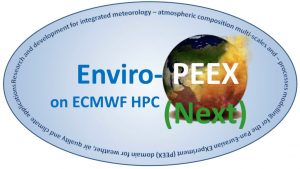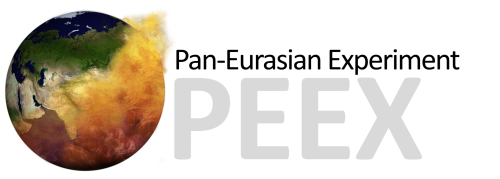Research and development for seamless modelling of meteorology – atmospheric composition on multi-scales for the Pan-Eurasian EXperiment (PEEX) domain for weather, air quality and climate applications (Enviro-PEEX(Next) on ECMWF, 2025-2027)

Research, Development and Application for PEEX-Modelling-Platform
The PEEX-MP (Mahura et al., 2024) presents a strategy for best use of current generation modeling tools to improve process understanding and improve predictability on different timescales within the PEEX domain, and also presents potential future developments. A number of application areas of new seamless modelling developments are expected to be considered, including: (i) improved numerical weather prediction (NWP) and chemical weather forecasting (CWF) with short-term feedbacks of aerosols and chemistry/aerosols on meteorological variables; (ii) two-way interactions between atmospheric pollution/ composition and climate variability/ change; (iii) better prediction of atmosphere and/or ocean state through closer coupling between the component models to represent the two-way feedbacks and exchange of the atmospheric and ocean boundary layer properties.
The PEEX-MP focuses on a new generation of integrated models and is based on the seamless Earth System Modelling (ESM) approach to evolve from separate model components to seamless meteorology-composition-environment models to address challenges in weather, climate, and air quality fields whose interests, applications and challenges are now overlapping. Several models, being a part of the PEEX-MP, are to be further developed and tested in this HPC project.
The overall objectives of this special project will be focused on (1) analysing the importance of the meteorology-chemistry/aerosols interactions and feedback, and on (2) providing a way for development of efficient techniques for seamless coupling of NWP and ACT models via process-oriented parameterizations and feedback algorithms. Such coupling will improve the numerical weather prediction, climate and atmospheric composition forecasting.
Expected Results
The main application areas of the seamless modelling approach are expected to be considered:
- improved numerical weather prediction with short-term feedbacks of aerosols and chemistry on formation and development of meteorological variables;
- improved atmospheric composition forecasting with seamless meteorological forecast and two-way feedbacks between aerosols/chemistry and meteorology;
- coupling of aerosols and chemistry with aiming towards more realistic description of aerosols and relevant microphysical processes, and their effect on radiative fluxes and clouds;
- improved understanding and ability in prediction of chemical and physical processes related to the formation and growth of atmospheric particles.
The emphasis in this HPC project at ECMWF is primarily on the testing and evaluation of selected models of the PEEX-Modelling-Platform and sensitivity analyses the feedback mechanisms for weather, climate and atmospheric composition modelling.
Simulations are expected for:
- short-term case studies with physical and chemical weather forecasting (downscaling from hemispheric-regional-subregional to urban/ city scales) in order to evaluate sensitivity of aerosol feedback effects on meteorology, atmospheric composition and climate.
- episodes simulations for weather, climate and air quality applications to evaluate possible effects.
- testing of parameterisations, meteorological and chemical initial and boundary conditions, and chemical data assimilation.
The computational resources will be used mainly to experiment with newly developed components of the modelling systems and evaluate their performance and sensitivity to feedbacks. In-depth validation and intensive testing of all these developments will be carried out at UHEL, mentioned Universities and research institutions as well as ECMWF environments.
Contact Information
- PI – Dr. Alexander Mahura, Institute for Atmospheric and Earth System Research, INAR/ UHEL
- e-mail: alexander.mahura@heslinki.fi
- https://researchportal.helsinki.fi/en/persons/alexander-mahura
- https://www.researchgate.net/profile/Alexander_Mahura
More details (extended introduction, models for research and development, scientific developments, overview of projects that benefits, partners of the project, workplan with main application areas and expected simulations, new developments towards PEEX-Modelling-Platform, etc.) are available in the “Enviro-PEEX(Plus) on ECMWF HPC” proposal at:
- https://www.ecmwf.int/sites/default/files/special_projects/2025/spfimahu-2025-request.pdf
- in future the reporting will be available at: https://www.ecmwf.int/en/research/special-projects/spfimahu-2025
Project Partners/ Teams
- UHEL – University of Helsinki, Finland
- FMI – Finnish Meteorological Institute, Finland
- UHMI – Ukrainian Hydrometeorological Institute, Ukraine
- UCPH – University of Copenhagen, Denmark
- KazNU – Al-Farabi Kazakh National University, Kazakhstan
- MPI-for-BioGeoChem – Max-Planck Institute for Biogeochemistry, Germany
- UiT – The Arctic University of Tromso, Norway
